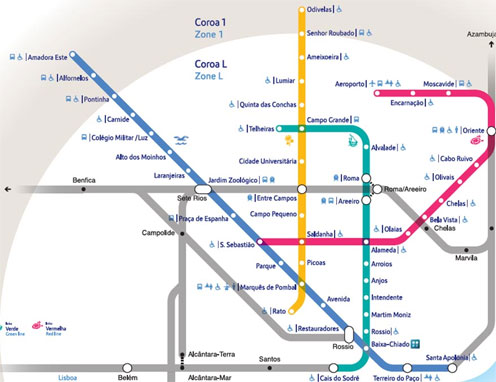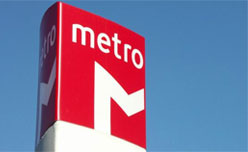Lisbon metro – practical information for tourists
In most European capitals, underground is one of the quickest and the cheapest alternatives of public transportation.
In Lisbon, often referred to as ‘the city on seven hills’, metro is also possibly the most convenient way of getting around; the Portuguese capital’s hilly terrain and cobblestone pavements can be challenging during long walks and the traffic jams are notorious.
Inaugurated in 1959, the Lisbon metro is fairly modern and efficient. With the rapid development registered in the recent decade, it is offering each time better coverage, allowing to reach each even quite remote areas.

As per mid-2017, Lisbon metro network consists of 55 stations distributed along 4 colour-coded lines.
If you are a tourist on a budget in Lisbon, much cheaper accommodation in the suburbs, does not mean you will be completely isolated from the heart of the city.
Lisbon Airport to the city centre by metro
A large majority of visitors to Lisbon is already introduced to the metro at the airport. Lisbon Airport (officially known as Humberto Delgado Airport and unofficially as ‘Portela’) is very conveniently connected to the city’s metro system, by the Red Line / Orient Line.
As you can see on the map higher above, the Red Line intersects with all three other Lisbon metro lines: the Blue Line (or the Seagull Line), the Green Line (or the Caravel Line) and the Yellow Line (or the Sunflower Line).
The underground station is located just off the arrivals terminal. The trip to downtown Lisbon, with the line change at Alameda station, takes approximately 40 minutes.
Lisbon metro working hours and tickets
The metro runs from 6:30 am to 1 am every day, meaning that the first train of the day leaves from the terminal station at 6.30 am and the last one, at 1 am. The station halls are closed for the night, for cleaning and maintenance.
Trains run every 6 to 9 minutes, depending on the time of the day.
Lisbon metro tickets can be purchased at the stations, at the ticket offices or from the ticket machines.
The tickets machines are easy to use, even for non-Portuguese speakers, as they provide clear instructions in multiple languages. If you prefer, of course, to buy your metro fare at the ticket office, the chances are you will have to queue and it is not guaranteed that the sales person will speak any other language than Portuguese.
Ticket machines in Lisbon metro
When using the metro for the first time, it is necessary to purchase a rechargeable VIVA Viagem card, at a cost of 50 cents. The card can be used to purchase a variety of tickets, from single trips, to 24-hour day pass.
Keep your card at hand, as for each trip you will need to use it twice, swiping it at the entrance to the metro station and in order to exit.
The VIVA card can also be used on other means of transportation: busses, trams and ferries in the Lisbon area. The card is valid for a year, after which a new card must be purchased.
Lisbon metro fares are:
- a single trip ticket – EUR 1.45; valid for one journey during 60 minutes after validations. During the journey you can switch the lines.
- a metro day pass – EUR 6.15; valid for 24 hours after the first validation.
- a single trip in the zapping mode – EUR 1.30. In order to use zapping mode, charge your VIVA Viagem card with amounts from 3 to 40 euros and use the balance according to your needs.
Where Lisbon metro doesn’t reach
Although the Lisbon metro reaches quite far out in direction of the north-western suburbs of the city, it doesn’t not cove some of the most popular tourist areas west of the city centre. This is the case of the riverside Belem area where the famous Belem Tower, the Jeronimos Monastery and the Monument to the Discoveries are located. You can reach by a tram from Praça do Comércio or by train from the Cais do Sodré station.
Neither will you be able to use metro to get to Cascais, a popular tourist resort west of Lisbon, or any of the towns along the coast on the way to Cascais, many of which are known for quality beaches and hotel infrastructure. Once again, the metro takes you as far as to Cais do Sodre station, which is a terminus of the suburban train line known as Linha de Cascais (Cascais Line).
If you are planning to travel outside the strict Lisbon centre, to Cascais or to the UNESCO World Heritage Site, Sintra town, consider renting a car: Lisbon car hire – compare offer and book online


